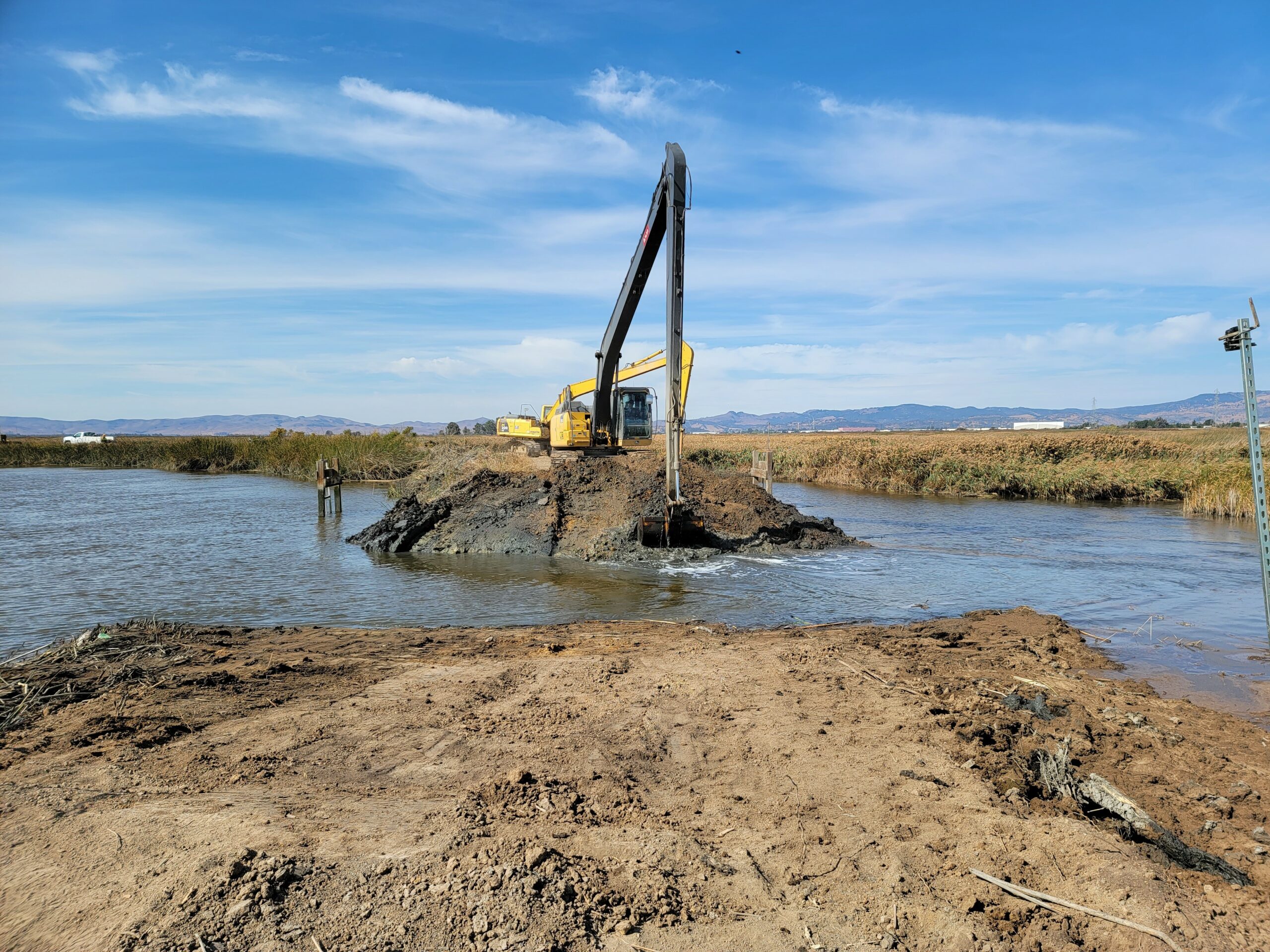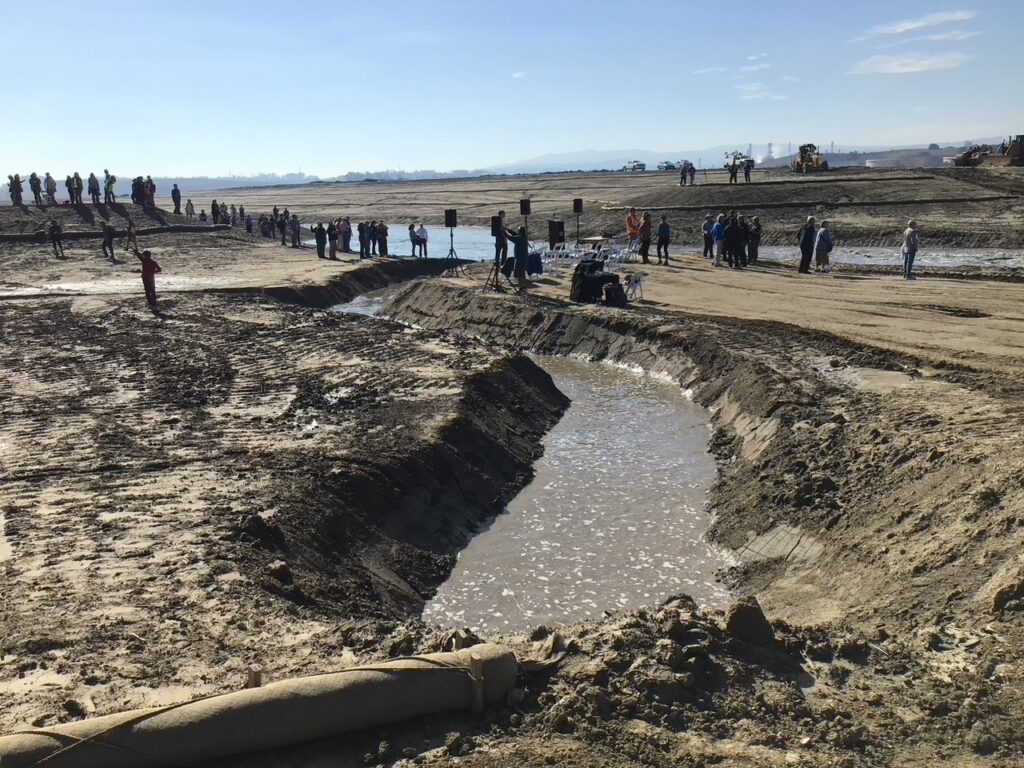
In the life of a tidal wetland restoration project, the first levee breach is a major milestone, a kind of graduation. After years of securing funding, navigating the permit process, completing baseline biological surveys, filing endless reports, grading and sculpting the marsh plain, setting out plants—after all that comes the day when the earthen barrier crumbles, the water makes its move, and another marsh can start to regenerate. This fall, that’s happening around the Bay Area as three significant projects—Dutch Slough and Lower Walnut Creek in Contra Costa County and Hill Slough in Solano County—renew long-severed connections between water and land.
The three projects involve two state agencies, a county district, and a nonprofit. Dutch Slough is a California Department of Water Resources project on about 1200 acres of former farmland just south of Jersey Island. Lower Walnut Creek, encompassing Pacheco Marsh, is a joint venture between the Contra Costa County Flood Control District and the John Muir Land Trust, and a novel undertaking for both partners. “Flood Control was traditionally a single-purpose district, but more recently has embraced a watershed stewardship role,” notes senior civil engineer Paul Detjens.
Land Trust executive director Linus Eukel says 232-acre Pacheco Marsh, at present a degraded seasonal wetland, is the trust’s first tidal marsh restoration project. It’s envisioned as a refuge for tidal-marsh wildlife when existing marshes are overtaken by sea-level rise. The Hill Slough site, where eight diked ponds managed by the California Department of Fish and Wildlife (CDFW) as waterfowl habitat will be replaced by 649 acres of tidal marsh, is part of the agency’s Hill Slough Wildlife Area, near Suisun Bay.

Levee breaches are underway at all three locations: four at Lower Walnut Creek, five at Dutch Slough, thirteen at Hill Slough. Detjens explains what’s involved in a typical breach: “We’ll be using a large excavator positioned at the side of the last remaining bit of soil in the new channel. The operator will skillfully remove scoops of soil and set it aside until the pressure of the tides takes over and water rushes in. Then the operator removes the remaining soil to make that part of the channel the same size as upstream and downstream.”
Sarah Estrella, an environmental scientist with CDFW, says the clustering of breaches reflects regulatory constraints: they have to be completed between September 1 and November 30 to avoid impacts on special-status birds and fish. Tides set further constraints. “We’ll do the breaches at Lower Walnut Creek on a high tide to minimize the release of sediment,” says Detjens.
Dutch Slough project manager Katherine Bandy says the breaches there will happen on a low, incoming tide, at the time when water elevations in the slough balance with water levels within the site. There’s also a turbidity curtain in the slough to minimize the impact of removing the final dirt plug. Supply chain ripple effects complicated the timing of the work at Dutch Slough. Originally, DWR planned to build pedestrian bridges over the breach points before the actual breach, but shortages of construction material forced them to interrupt the bridge-building and complete it after the breach.
Dutch Slough began to change even before the breaches. “As soon as we put water onto the site, wildlife starting showing up,” says Bandy. “They wasted no time getting out there. It started at the tail end of 2019 with our irrigation infrastructure—flood irrigation for the tules, drip irrigation for the trees and shrubs. The flood irrigation attracted shorebirds in crazy numbers in the spring of 2020. As the vegetation filled in, we had birds coming into all the vegetation types.”
Observers have spotted marsh species like Virginia rail and sora, and the secretive American bittern. Northern harriers and other raptors began cruising for prey. Bandy hopes that special-status birds like the California black rail, historically present at the site, and the Ridgway’s rail will put in an appearance. Mammals showed up too: river otters, mink, muskrats, raccoons, coyotes. Even a wandering black bear left its tracks.
As the natural community rebuilds and ecological processes kick in, platoons of researchers will use Dutch Slough as a living laboratory. Some have already done pre-breach baseline surveys; others will watch as things evolve over time. “The US Geological Survey will be out there studying how carbon moves through plants, soils, and water”, Bandy explains. “UC Berkeley researchers will be looking at lateral carbon flux. UC Davis and Cramer Fish Sciences will do fish sampling and aquatic food web studies. It all goes hand in hand with our adaptive management policy—marrying science with land management. The research data will help us learn how to better manage the site.”
Bandy adds that DWR welcomes any researchers who bring their own funding: “There’s a lot of opportunity for whatever people are interested in trying to do with wetland research.”
UC Berkeley scientists are also conducting greenhouse gas studies at Hill Slough. Wildlife being monitored there include western pond turtles, a California species of special concern. “We hadn’t realized how many turtles there were on the site,” says Estrella. The water is too brackish for the exotic red-eared sliders that compete with pond turtles elsewhere. The reptiles are trapped in hoop nets and outfitted with radio transmitters, glued to their shells.
Salt marsh harvest mice are also being studied at the site. Estrella says the restored marsh at Hill Slough will provide habitat connectivity for the mouse, the Ridgway’s and California black rails, and two special-status plants, the Suisun thistle and soft bird’s-beak. Pacheco Marsh is also salt marsh harvest mouse and black rail habitat; Ridgway’s rail is hoped for but not yet confirmed. According to Detjens, Lower Walnut Creek, while not optimal for spawning salmonids, is potentially good rearing habitat for Chinook salmon smolts on their outward migration.

Hill Slough will be open to the public for fishing, birding, and wildlife observation, but, unlike the nearby Grizzly Island Wildlife Area, not for hunting. A two-mile loop trail, connected to Suisun City’s Grizzly Island Trail, is already in place. Public access is central to the John Muir Land Trust’s plans for Pacheco Marsh, with trails, blinds for birding, and kayak launches. “It will be a wonderful site for birders,” says Eukel. There will also be an environmental education center, still in the design phase: “There are disadvantaged communities nearby, kids who live in Bay Point who have never been to the Bay. This will help them understand how salt marshes are vital.”
Public access at Dutch Slough is farther off: “We’re just getting to the phase where we can focus on developing trails and be ready to bring people out,” Bandy says. That may happen within the next couple of years. DWR is partnering with the city of Oakley to link a 55-acre city park to the wetlands, and the East Bay Regional Park District plans to extend the Marsh Trail to Dutch Slough.
Estrella has invested nine years at Hill Slough. Her reaction to the project’s completion: “It’s a big relief.” Detjens has led the Lower Walnut Creek project for 18 years. Bandy, who took over as project manager after Patricia Finfrock retired, says she’s a relative newcomer to Dutch Slough. “Some people have been working on it for 20 years,” she reflects. “Being here at this moment when you’re watching it come to life, seeing the animals responding immediately, is so satisfying. It’s amazing to be part of it, seeing it happen for real.”
Top Photo: Hill Slough breach. Courtesy Sarah Estrella, CDFW
Prior Estuary Stories
LINKS
Lower Walnut Creek (Contra Costa Flood District)